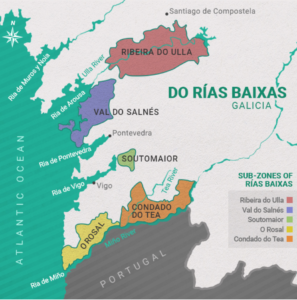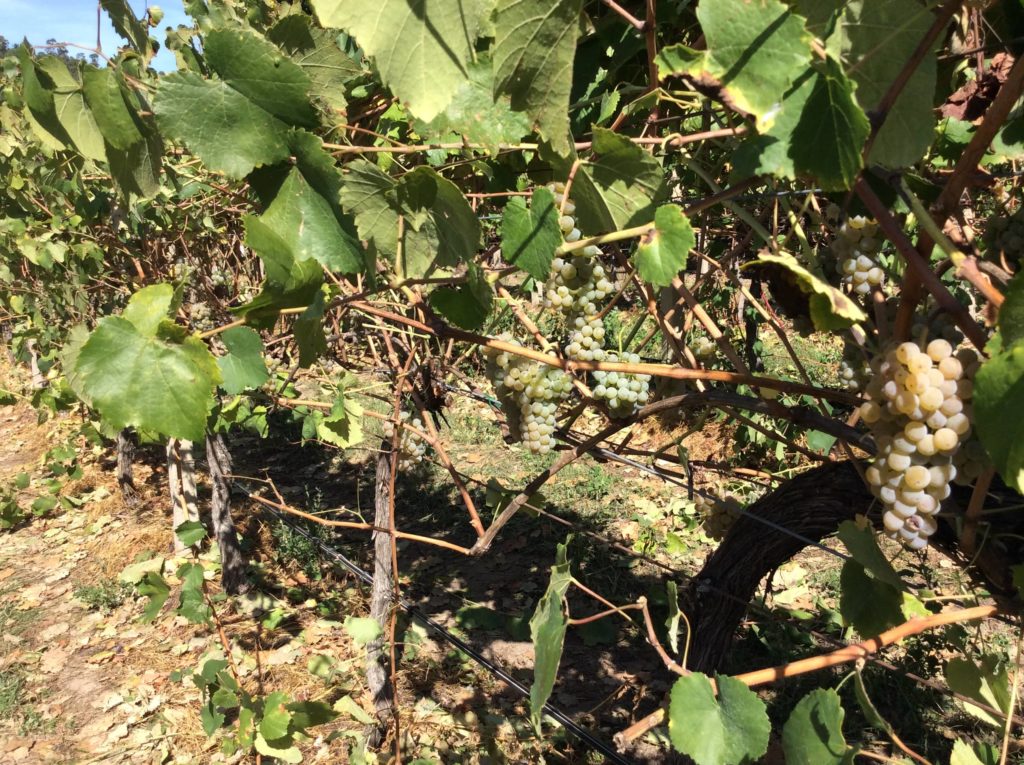Rías Baixas is practically synonymous with Albariño, and it’s not hard to see why. With the greatest concentration of Albariño vineyards in the world, Rías Baixas DO is considered the birthplace of this unique Galician variety and Albariño still reigns supreme as the main wine made in this remote northwestern corner of Spain, just above Portugal. When I visited Rías Baixas, I met up with consultant winemaker in the region and local expert, Pablo Estévez, to share with us his ultimate Rías Baixas and Albariño guide.
We spent the day visiting the pristine vineyards of Finca Garabelos where José and his wife Teresa meticulously look after their vines to make two different Albariño wines: La Trucha and Finca Garabelos. The peak of harvest can be a tense time but José and Teresa were as excited as small children at their beautiful grapes coming in. Obtaining healthy grapes is a challenge in the wet maritime climate of Galicia but the thick skins of Albariño cope perfectly with the conditions.
Fortunately I visited on a gorgeous, sunny day. After the morning harvest and grape sorting finished, while sipping on a golden glass of Albariño, I asked Pablo to divulge the secrets of Rías Baixas and Albariño in this expert video interview:
Pablo’s Albariño guide and interview is in Spanish, so make sure to activate the subtitles if you ‘no habla español’…
Albariño Guide
Where else Albariño is grown
Albariño today is grown far and wide, from Uruguay to New Zealand, but it is best known in Spain and Portugal in the neighbouring regions of Rías Baixas and Vinho Verde. It is native to this northeastern corner of Europe and particularly well adapted to the wet maritime climate.
What does Rías Baixas mean?
Pablo told me that the region of Rías Baixas was actually known as Albariño at one point, which is unsurprising given it is the most important wine variety in the region. Rías Baixas is the DO (Denomination of Origin) and any wine labelled as Rías Baixas has to come from the region and have at least 70% Albariño in the blend. Although Albariño vines dominate (it makes up 90% of plantings), there are 12 varieties permitted in the Rías Baixas DO and common blending grapes are other local varieties: Loureiro, Treixadura and Caiño.
Rías Baixas actually means lower rivers in the local dialect, and it is a reference to the Ulla and Miño rivers running into the sea.
Subregions of Rías Baixas

Subzones of Rias Baixas
There are five subregions of Rías Baixas (all specialising in Albariño):
- Ribeira do Ulla – the newest and northernmost subregion. This region is inland with the Ulla River running through. It is one of the coldest subregions, along with Val do Salnés, but being inland it is a bit drier.
- Val do Salnés – northern and closest to the coast, Val do Salnés hugs the coastline and is the wettest and coolest subregion. It is the oldest subregion and has the most area under vine.
- Soutomaior – the smallest of the subregions, it is located inland but faces the Vigo natural bay. Hilly.
- Condado de Tea – one of the southernmost (with O Rosal) and bordering Portugal. The difference between Condado and Rosal is that Condado is inland and is therefore warmer and drier. It is the second largest subregion and formed of hillsides and terraced vineyards.
- O Rosal – also one of the southernmost subregions, but closer to the coast with a cooler and wetter coastal climate. Hillsides and terraces.
Climate of Rías Baixas

Albariño: a thick-skinned variety
Rías Baixas, and Galicia in general, is the greenest part of Spain with the wettest conditions and high rainfall (1,700mm per year). The temperatures are also much cooler, influenced by the cold, Atlantic coastline. However it can get warmer further inland where there is no morning fog influence.
The reason Albariño is so well-adapted is because its thick skins are more resistant to rot and humidity.
Soils of Rías Baixas
The soils across the region are dominated by granite, and in some places you’ll find schist. The granite is great for drainage (important in a damp area like this) and is also notably used in the vineyards as poles and building material.

Granite: essential to the soils & vineyard posts
Viticulture in Rías Baixas
Because of the high humidity, keeping air flow between the grapes is essential to avoid rot. Parral is the traditional vineyard training system, keeping the grapes high above the ground (and its humidity). However warmer and drier regions like Condado can manage with espaldera (as in the photo). The growers make sure they keep the canopies open with good air movement, especially close to the harvest period.

An example of espaldera, with open canopies, in Condado
Albarino guide to winemaking
Selection as the grapes come into the winery is also an essential part of avoiding any rot and spoilage from the wet weather conditions.

Hand-sorting grapes to ensure
Following that, winemakers usually ferment in stainless steel to maintain the fresh, fruit-forward character of Albariño. More complex styles are made by leaving the wine over its lees for several months to add more texture and complexity on the palate.
Typically Albariño has high acidity and bright stone fruit and floral aromas. It can also have quite a salty, mineral note, and vintages can vary wildly.
Albariño tasting notes

La Trucha
José and Teresa’s flagship wine, and their largest production, this is a lively, younger version of Albariño, which has had just three months on the lees to fill out the mid-palate. Bright, fresh and pretty, it is exactly the sort of Albariño you want to quaff before dinner, or with fresh seafood.
La Trucha Vendimia Tardia
This is a limited edition wine from their La Trucha line and it is harvested a bit later, offering greater ripeness of fruit, full and warm aromatics with a much fuller mouthfeel. The big sister to La Trucha.
Finca Garabelos
This is José and Teresa’s smaller production Albariño, which spends about six months on the lees, depending on the vintage. It usually comes from their older vines and the wine is more concentrated. Older, warmer, vintages (like the 2012) show waxy notes of lemon peel and almonds, whereas 2014 still has an incredible freshness and floral finish. Each vintage has its own personality and these are wines to keep, enjoy and explore.
Rías Baixas & Albariño guide interview transcript
Pablo, for how long have you been making Albariño?
Well, this year it is 16 years working here in Rías Baixas DO.
Perfect, and how is Albariño in the vineyard – as a grape variety? Are they big grapes, small grapes?
No, it’s quite a loose bunch and spherical and small bunches.
And how does it behave here in the climate? Explain to us a bit about the climate of Rias Baixas and how the variety adapts to the region?
It’s very well adapted. It is a variety that finds adequate alcoholic levels and at the same time it conserves acidity. So we have wines that are very aromatic and balanced.

Harvesting in Condado
And how much is the average alcohol and acidity in a normal harvest (if that exists!)
On an average harvest it is between 12-12.5, and acidity at 8, 8.5. This is a normal harvest. In some harvests, like last year, the levels can be a bit higher, which is possibly to do with climate change.
And the acidity?
In the last few years it has been adequate, values between 7.5 and 8.5. It is what I personally like in this style of wines.
And you manage vineyards in different ways here, tell me a bit about the difference between the parrals and other systems.
Yes, the habitual here in Rias Baixas is the parral. The parral helps the humidity to escape, because here we have an Atlantic climate and some years with a lot of rain. And so it helps separate the grapes from this humidity. The sub-zone we are in here, El Condado, we don’t have the same high level of rains as on the coast, it is a bit more of a transitional climate. And here we get both systems of training – the parral and espaldera.
And what differences do we find within Rías Baixas? Within the region, we have sub-zones that are more coastal, and others that are more inland. What diversity is there of climate, soils and aspects and how does that influence the character of Albariño in the glass?
Of course. Rías Baixas has 5 sub zones. The most productive and important in terms of volume is Salnés. Then at the north of Galicia, Ulla. Then by the Miño river we have Condado and Rosal. And then another, which is small but significant, Soutomaior. I work in many of them and, yes, I see the same variety but in different forms. Especially in their levels of acidity and aromatic profiles. It’s clear the variety behaves in a different way [in each place].
And in the zones closer to the sea, the acidity is higher?
Yes, that’s normal. The acidity is higher in regions that are more coastal and humid. They can also mature slower than the regions further inland.
Great, and can you explain to me the general character of Albariño? What aromas will we find, how is the body?
One of the principal characteristics is the aroma. It is intense, clean, with floral and fruit aromas. And this would be the principal characteristic of this variety. And this is united with the moderate alcohol… wines with lots of acidity, well-structured, and wines that are well sought after today in the market.
Perfect, and there are different styles of Albariño too – younger, fresher styles in stainless steel, and then you have more complex styles on the lees. Will you explain to us the diversity that you can find in Albariño within Rías Baixas?
Yes – as you say, the most common is fermented in stainless steel with controlled temperatures to make a young wine. But it’s also true that people are looking more and more towards styles with some age, sometimes keeping the wine on its lees for a certain time, and we get a very different profile of wine which also has its own fans. And then within Rias Baixas, it isn’t all Albariño! They aren’t all single variety wines, you can also find blends – here in particular blends with Albariño and Treixadura, or with Louerra and Godello. And in other subzones there is the Rías Baixas Rosal with Loureiro.

